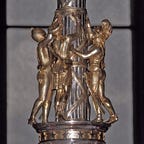Napoleon as the Peacemaker
Ricky Hitching
‘’I have read that the ancients, when they had produced a sound, used to modulate it, heightening and lowering its pitch without departing from the rules of harmony. So must the artist in working at the nude.’’ — Antonio Canova
This principle helped Antonio Canova to create one of the most deliberate examples of ‘’the emperor wears no clothes’’ in art history: Napoleon as Mars the Peacemaker. This colossal relic was the result of Napoleon’s desire to set his reputation among military legends dating back to the Roman Empire — but just like the collapse of the Roman Empire itself, so too did Napoleon at the Battle of Waterloo in 1815. To add insult to injury, the marble statue, originally designed to portray Napoleon as the father of modern France, currently resides in the former home of his enemy, the 1st Duke of Wellington, at Apsley House. This formidable irony, though, is not without its backstory!
Napoleon Bonaparte met Venetian artist Antonio Canova during the Italian campaigns of 1796 and 1797. Willing to exploit the talents of this fresh artist, he pledged to protect Canova once France had achieved victory in his military campaign. In 1802, as military dictator of France, Napoleon summoned the sculptor to Paris insisting that he create a glorified marble portrait statue displaying himself as a role model to his people. At first, Canova refused to accept the commission, presumably because of his animus towards the French court as well as Napoleon; but he was forced to attend Paris and fulfil Napoleon’s demands due to constant pressure from the papacy. As Napoleon became more popular from the peace treaties of Lunèville and Amiens, Canova’s forced association would make him very famous upon his return to Rome to begin the work. It was supposed to be a work of worship, but instead Canova pursued his own vision of the French Emperor.
The statue took four years since commission, between 1802 and 1806, to complete. Standing at 3.45 metres tall, the artwork draws upon the ideal of physical and athletic nudity. It is based on the image of Augustus, the first Roman emperor, and evokes Napoleon as the second coming of the Roman Principate in the French Republic, recognising his comparable qualities as statesman to the Roman Emperors. Nudity serves as the image of divinity, as referenced by classical sculpture, transcending Napoleon to god-like status. His left arm, raised and grasping a staff, postures a sense of authority and power over his subjected audience. Inspired by Pope Pius VII’s desire for warless futures, Canova opted to present Napoleon as a mythological emblem of peace. Yet by doing so, he rejected the idea of attiring the marble statue in contemporary dress with respect to the ‘’heroic altogether’’: that the authority of the ancients is immortal and forever enshrined through superior achievement.
Before sculpting, Napoleon and Canova had disagreed strongly on how the emperor should be represented to the people and his critics. As Napoleon urged for the statue to present him in French military attire, Canova believed passionately that nudity is the only quality that could meet Napoleon’s taste: ‘’God himself would not have been able to create a beautiful work of art if he had represented Your Majesty as you are, dressed in the French fashion.’’ Reluctantly, all Napoleon could do was accept the stance of his hired artist. His anxieties to artistic nudity were a feeling all too common with the French public, whom Canova predicted correctly to react with disgust: ‘’The statue of the Emperor will one day come to Paris; it will be criticised without pity, and I know it: it will certainly have its defects, above all the others it will have the disgrace of being modern and by an Italian.’’
No criticism of the statue was as important as Napoleon’s, who finally came to see the statue in 1811. As Canova expected, the Emperor disparaged the work as an affront to the values of the French Republic partly because of his insecurity behind the comparison to his actual physique. The Emperor, who at first anticipated the display of the marble colossus in his honour inside the Louvre (which he renamed Musèe Napolèon), instead banished what he described as ‘’too athletic’’ from public view behind a canvas screen in the Salle des Hommes Illustrès, It would be unsurprising if Canova drew a sigh of relief when the work was strongly rejected; not only was he unwilling to sculpt a portrait of the man he distrusted, but also sticking firmly to his principles of what art means to him: aesthetics over politics.
It was not until 1816, just after the fall of Napoleon at the Battle of Waterloo, that the statue would be admired by the British government. Once the Louvre reverted to its original museum, the statue was available for purchase. It was sold to the British government, who then gifted it to the Duke of Wellington a year later for storage in his stately home, Apsley House. Wellington’s opinion of the statue is still unknown, but as much as The Iron Duke held tremendous respect for who he considered the greatest general in history, it is easy to imagine an egotistical grin upon his face as he strode past the man he defeated. The presence of Wellington’s nemesis inside his own home can still raise eyebrows amongst visitors today.
For Canova, it could be argued that he set a new precedent in the artistic world: that art lies within the artist, and the artist only.
